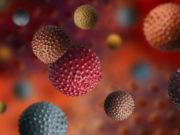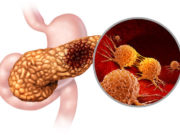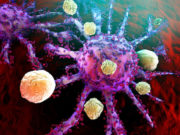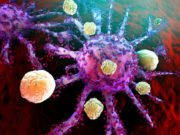What if it was possible to detect mutating cells before they turn into full-blown cancer?
 Researchers from the University of Queensland in Australia are working towards that goal with their new “universal” cancer test. Still in its early stages of development, the test looks at the DNA structure that cancerous cells take on when they are placed in water. In less than 10 minutes, the tool can identify inconsistencies in the cells that likely point to cancer.
Researchers from the University of Queensland in Australia are working towards that goal with their new “universal” cancer test. Still in its early stages of development, the test looks at the DNA structure that cancerous cells take on when they are placed in water. In less than 10 minutes, the tool can identify inconsistencies in the cells that likely point to cancer.
This test could change the face of cancer detection by potentially eliminating the need for expensive and invasive biopsies. But don’t look for it in your doctor’s office just yet. It has a long way to go before it will be ready for doctors to use.
Although the test will certainly allow for more people to afford and access cancer diagnostics, it’s still a bit limited in scope. It can’t identify the specific type of cancer that someone has, for instance, and it can’t tell you how advanced that cancer is.
So how does it work?
 Normally-developing human cells use a pattern of molecules that cling to DNA called methyl groups. Without this consistent pattern, the cells can’t function properly. Cancerous cells contain erratic distribution patterns, which causes mutated genes to multiply. Other researchers have noted this trend in the past, but the Queensland researchers are the first to look at methyl patterns of DNA samples in water.
Normally-developing human cells use a pattern of molecules that cling to DNA called methyl groups. Without this consistent pattern, the cells can’t function properly. Cancerous cells contain erratic distribution patterns, which causes mutated genes to multiply. Other researchers have noted this trend in the past, but the Queensland researchers are the first to look at methyl patterns of DNA samples in water.
 When the malignant DNA samples are put in water, they separate into three-dimensional shapes. This discovery allowed the Queensland team to create the test that looks at DNA behavior with the addition of gold particles. Gold particles are usually well-stocked in labs because they change colors in the presence of certain molecules, which allows for easy detection. The Queensland team added samples of the DNA to water with gold particles that turned the water pink. The malignant cells, when placed in the water, remained pink. But the healthy cells turned blue.
When the malignant DNA samples are put in water, they separate into three-dimensional shapes. This discovery allowed the Queensland team to create the test that looks at DNA behavior with the addition of gold particles. Gold particles are usually well-stocked in labs because they change colors in the presence of certain molecules, which allows for easy detection. The Queensland team added samples of the DNA to water with gold particles that turned the water pink. The malignant cells, when placed in the water, remained pink. But the healthy cells turned blue.
Although this unique method has not yet been tested on humans, it has detected cancerous cells in more than 200 tissue and blood samples. So far, it has detected breast, prostate, and bowel cancers, as well as lymphoma.
 The test shows great promise as a simple, affordable, and accessible test that can potentially detect the presence of cancerous cells. But according to the study’s co author, Matt Trau, “We certainly don’t know yet whether it’s the holy grail for all cancer diagnostics.”The vague nature of the test may open up the door for many false positives and needless anxiety. Potential concerns lie in the fact that the test’s lack of specificity could ultimately just lead to more unnecessary tests.
The test shows great promise as a simple, affordable, and accessible test that can potentially detect the presence of cancerous cells. But according to the study’s co author, Matt Trau, “We certainly don’t know yet whether it’s the holy grail for all cancer diagnostics.”The vague nature of the test may open up the door for many false positives and needless anxiety. Potential concerns lie in the fact that the test’s lack of specificity could ultimately just lead to more unnecessary tests.






















 Researchers from the University of Queensland in Australia are working towards that goal with their new “universal” cancer test. Still in its early stages of development, the test looks at the DNA structure that cancerous cells take on when they are placed in water. In less than 10 minutes, the tool can identify inconsistencies in the cells that likely point to cancer.
Researchers from the University of Queensland in Australia are working towards that goal with their new “universal” cancer test. Still in its early stages of development, the test looks at the DNA structure that cancerous cells take on when they are placed in water. In less than 10 minutes, the tool can identify inconsistencies in the cells that likely point to cancer. Normally-developing human cells use a pattern of molecules that cling to DNA called methyl groups. Without this consistent pattern, the cells can’t function properly. Cancerous cells contain erratic distribution patterns, which causes mutated genes to multiply. Other researchers have noted this trend in the past, but the Queensland researchers are the first to look at methyl patterns of DNA samples in water.
Normally-developing human cells use a pattern of molecules that cling to DNA called methyl groups. Without this consistent pattern, the cells can’t function properly. Cancerous cells contain erratic distribution patterns, which causes mutated genes to multiply. Other researchers have noted this trend in the past, but the Queensland researchers are the first to look at methyl patterns of DNA samples in water. When the malignant DNA samples are put in water, they separate into three-dimensional shapes. This discovery allowed the Queensland team to create the test that looks at DNA behavior with the addition of gold particles. Gold particles are usually well-stocked in labs because they change colors in the presence of certain molecules, which allows for easy detection. The Queensland team added samples of the DNA to water with gold particles that turned the water pink. The malignant cells, when placed in the water, remained pink. But the healthy cells turned blue.
When the malignant DNA samples are put in water, they separate into three-dimensional shapes. This discovery allowed the Queensland team to create the test that looks at DNA behavior with the addition of gold particles. Gold particles are usually well-stocked in labs because they change colors in the presence of certain molecules, which allows for easy detection. The Queensland team added samples of the DNA to water with gold particles that turned the water pink. The malignant cells, when placed in the water, remained pink. But the healthy cells turned blue. The test shows great promise as a simple, affordable, and accessible test that can potentially detect the presence of cancerous cells. But according to the study’s co author, Matt Trau, “We certainly don’t know yet whether it’s the holy grail for all cancer diagnostics.”The vague nature of the test may open up the door for many false positives and needless anxiety. Potential concerns lie in the fact that the test’s lack of specificity could ultimately just lead to more unnecessary tests.
The test shows great promise as a simple, affordable, and accessible test that can potentially detect the presence of cancerous cells. But according to the study’s co author, Matt Trau, “We certainly don’t know yet whether it’s the holy grail for all cancer diagnostics.”The vague nature of the test may open up the door for many false positives and needless anxiety. Potential concerns lie in the fact that the test’s lack of specificity could ultimately just lead to more unnecessary tests.





